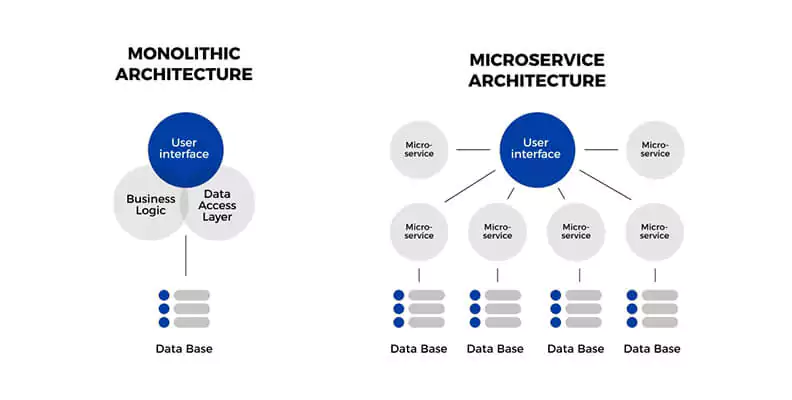Loading.....
Power of Microservices: Revolutionizing the Way We Build Software

Hey there, amazing folks! 🚀 Welcome to an exciting journey into the world of Microservices Architecture. We're about to embark on a discovery that will transform the way you think about software development.
In this blog, we're diving deep into the realm of Microservices, where we'll explore why forward-thinking companies are embracing this revolutionary approach. Buckle up, because by the end of this read, you'll have answers to some of your burning questions.
Monolith Architecture v/s Microservices Architecture

What Is Monolithic Architecture
A monolithic application is a software system where all of its functions and features are tightly bundled within a single, unified codebase. It's a familiar concept for many of us, as we've likely encountered it while working on projects.
When tasked with designing a monolithic application, we're essentially given a problem statement and asked to create a system that encompasses various functionalities. In the development process, we typically structure the application into different layers, such as presentation, service, and persistence.
Once this comprehensive codebase is ready, it's deployed as a single, self-contained file, often in the form of a jar or war file. In essence, a monolithic application is exactly what it sounds like: "mono" signifies the singularity of the codebase, which houses all the essential functionalities and components of the system.
Monolithic Architecture Development
Imagine building a large, complex puzzle. In a Monolithic approach, you start with a massive puzzle where all the pieces are interconnected. Here's how it affects development cycles:
- Sequential Development: You work on solving the entire puzzle piece by piece, starting from one corner and moving across. You must finish solving one part before moving on to the next. If you get stuck on one piece, it can delay the entire process.
- Dependency Bottlenecks: If you want to make changes or improvements to one section of the puzzle, you might need to take apart or adjust the adjacent pieces. This can create bottlenecks and slow down development, as one change can impact other parts.
- Risk with Deployments: When it's time to show the completed puzzle, there's a high risk. If you missed something along the way, it can be challenging to fix without taking the whole puzzle apart.
What Are Microservices Architecture
Microservices represent an architectural development style that transforms the way applications are structured. In this approach, an application is composed of smaller, self-contained services, each responsible for handling a specific portion of the application's functionality and data. These services communicate directly with each other, typically using lightweight protocols like HTTP.
As Sam Newman aptly puts it, "Microservices are the small services that work together."
One of the defining features of the Microservices architecture is the shift in how the application interacts with its database. Instead of sharing a single database with other microservices, each microservice maintains its own separate database. This may lead to some data duplication, but it is an essential element of this architecture, as it fosters loose coupling between services. Another advantage of this approach is that each microservice can choose the type of database that best suits its specific needs.
Every microservice forms a secure module boundary, allowing the flexibility of using different programming languages for each service. Microservices architecture encompasses a range of patterns and practices, such as service discovery and registry, caching, API gateways, communication, observability, security, and more. These patterns collectively contribute to the success and effectiveness of the Microservices approach.
Example: Now, think of Microservices as a collection of smaller, individual buildings in a city. Each building serves a unique purpose, and they all communicate through well-defined roads and pathways. In a Microservices architecture, the software is broken down into smaller, independent pieces, each handling a specific function, like a bank, a grocery store, or a school in a city.
Microservices Architecture Development
Now, imagine building the same puzzle, but each section of the puzzle is a separate, smaller puzzle piece. Here's how it affects development cycles:
Concurrent Development: Different teams or individuals can work on solving each section of the puzzle independently. They don't have to wait for others to finish their parts.You can work on multiple sections of the puzzle at the same time, making the development process faster.
Fewer Dependencies: Making changes or improvements to one section of the puzzle doesn't affect the other sections. They remain intact. This reduces bottlenecks, and changes can be made more easily without disrupting other parts.
Higher Feature Development Rate: When it's time to show the completed puzzle, you can confidently bring together all the separate pieces. Since each section is independent, there's less risk of something going wrong, resulting in a higher feature development rate.
Why Microservices is Good?
Microservices architecture offers a multitude of advantages that make it a popular choice for modern software development. Here are the top 5 benefits of why Microservices is considered a favourable approach:
- Scalability: Microservices allow applications to scale more efficiently. Each service can be independently scaled to meet specific demands, making it easier to handle increased workloads and provide a seamless user experience. This flexibility ensures that resources are utilized efficiently, reducing the cost of infrastructure.
- Faster Development and Deployment: Microservices promote agile development and continuous integration/continuous deployment (CI/CD) practices. Development teams can work on individual services, allowing for faster feature development and quicker releases. This agility enables companies to respond rapidly to market changes and customer feedback.
- Resilience and Fault Isolation: In a Microservices architecture, if one service experiences a failure, it doesn't necessarily impact the entire system. Services can be designed to be resilient and fault-tolerant, ensuring that the overall application remains operational even when some components face issues. This enhances system reliability.
- Improved Developer Productivity: Microservices enable different teams to work concurrently on various services. This separation of concerns enhances developer productivity, as they can focus on specific functionalities without having to understand the entire monolithic codebase. This specialization often results in cleaner, more maintainable code.
- Technology Diversity: Microservices allow for the use of different technologies and programming languages for various services. This flexibility empowers developers to choose the right tools for specific tasks, optimizing performance and ensuring that the architecture can adapt to changing technology trends over time.
Enterprises Benefiting from Microservices
Netflix stands out as one of the early pioneers of microservices, and its journey has become a well-discussed success story. The tale of Netflix embracing microservices dates back to 2009 when this approach was relatively unknown. Notably, they chose to establish their microservices architecture on the Amazon Web Services (AWS) platform.
The transition to microservices at Netflix unfolded gradually, following a deliberate series of steps. Initially, they shifted non-customer-facing applications, such as movie encoding, to this new architectural style. Subsequently, they worked on decoupling customer-facing components, including functionalities like account sign-ups, movie selection, device preferences, and configuration settings.
This transition process spanned over two years, reflecting the complexity of the task at hand. By 2011, Netflix proudly announced the successful completion of its monolithic system's transformation into a well-organized and efficient microservices architecture. This architectural shift marked a pivotal moment in Netflix's journey, allowing them to achieve the scalability, flexibility, and resilience that they are renowned for today.
Conclusion
In conclusion, our exploration of the world of Microservices Architecture has unveiled the transformative power of this approach in modern software development. It's a journey that challenges conventional thinking and offers a path to more agile and efficient development processes.
In the Monolith vs. Microservices showdown, we've seen that Microservices stand out as the agile champion, offering numerous advantages that make it the preferred choice for forward-thinking companies. With a focus on scalability, speed, resilience, developer productivity, and the flexibility to embrace diverse technologies, it's clear why Microservices have gained such popularity.
As you venture into the ever-evolving landscape of software development, consider Microservices as your trusted guide, leading you towards faster innovation, greater adaptability, and a future where your applications can scale effortlessly. The Microservices approach is not just good; it's transformative, and it's the way forward for modern software development. So, embrace the change and embark on your journey towards Microservices excellence.
 Back to blog
Back to blog












